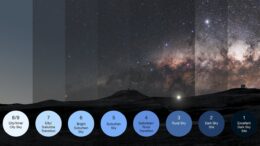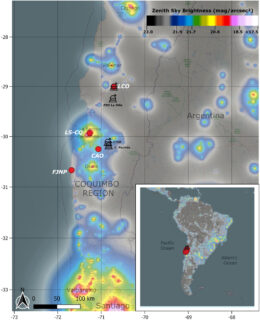Even Dark Sky Sites Aren’t Immune to Light Pollution
Share:Twitter Facebook LinkedIn Google+ Reddit Email

A projection of the night sky and La Silla observatory in Chile. [ESO/P. Horálek; CC BY 4.0]
Chile’s Coquimbo region is renowned for its starry skies and is home to some of astronomy’s most powerful and productive telescopes. In a recent article, researchers quantified the impact of artificial lighting on sites across the Coquimbo region for the first time and showed that we must actively preserve dark skies in remote areas and urban corridors alike.
Measuring the Impact of Light Pollution
An illustration of the Bortle scale value, which describes the degree of light pollution experienced in different settings. Click to enlarge. [ESO/P. Horálek, M. Wallner; CC BY 4.0]
Is the Milky Way visible from where you live? If so, consider yourself lucky — light pollution prevents a third of earthlings from seeing the Milky Way, including nearly 80% of North Americans and 60% of Europeans. The luckiest few are getting fewer, with less than 1% of residents in North America and Europe enjoying pristine night skies.
While city dwellers might make do with a dwindling number of visible stars, professional astronomical observatories rely on exquisitely dark skies. To understand the impact of light pollution on professional observatories as well as cities, Rodolfo Angeloni (Gemini Observatory) and collaborators assessed the degree of light pollution at four sites across Chile’s Coquimbo region: 1) Fray Jorge National Park, a certified Starlight Reserve; 2) Las Campanas Observatory, a professional astronomical observatory atop a mountain in the Atacama Desert; 3) Collowara Astrotourism Observatory, located near a city of 11,000 people; and 4) La Serena, a city of 450,000 people.
Angeloni’s team used ground-based all-sky imaging sensors to measure the brightness of the night sky at these locations on cloudless, moonless nights. By comparing the all-sky images to models of sky brightness and cross-referencing them with the positions of artificial light sources as seen from space, the team estimated the contribution of artificial light to the night sky brightness in each area.
Locations of Las Campanas Observatory (LCO), La Serena (LA-CQ), Collowara Astrotourism Observatory (CAO), and Fray Jorge National Park (FJNP) on a map of artificial night sky brightness. Click to enlarge. [Angeloni et al. 2024]
From Light to Dark
The measurements confirmed that Fray Jorge National Park is an exceptional dark sky site, with just 4% of the night sky brightness coming from artificial lights. (Scattered starlight, scattered sunlight, and airglow are natural sources of night sky brightness.) Fray Jorge National Park is one of the darkest measured sites in the world, and this study highlights the immediate need to protect this site from light pollution.
At Las Campanas Observatory, the future home of the 25-meter Giant Magellan Telescope, artificial lights contributed about 11% of the observed sky brightness, with the largest contributions coming from the cities of La Serena and Vallenar (117 and 49 kilometers away, respectively). Luckily, the impact of light pollution on the observatory is currently small, but the growth of nearby cities and the ongoing Pan-American Highway project could brighten the skies at Las Campanas.
Collowara Astrotourism Observatory, situated near the 11,000-person city of Andacollo, has artificial sky brightness comparable to that of Flagstaff, AZ, a much larger city. Another way of looking at this finding is that Flagstaff, named the world’s first Dark Sky Community in 2001, has night sky brightness comparable to that of a much smaller city — in other words, active efforts to reduce light pollution work, and cities worldwide can take proven steps to address the issue.
The sky brightness surrounding Las Campanas Observatory, with the major sources of natural and artificial sky brightness labeled. The Milky Way (MW) dominates at about 150 degrees, with La Serena (LS-CQ) just slightly less bright but extending to a lower altitude. The city of Vallenar is also a source of sky brightness. [Angeloni et al. 2024]
The skies surrounding La Serena are overwhelmingly brightened by artificial sources, and the impact of the bright city lights was felt far away; La Serena was the largest source of artificial sky brightness at the other three sites monitored. This result makes it clear that it’s important to reduce light pollution in overly bright areas like La Serena, as these bright regions impact the sky brightness in distant locales, and it’s critical to preserve the few truly dark sites that remain. Angeloni’s team plans to continue their efforts in the region by continuously monitoring the sky brightness in La Serena and installing 40 more sensors in dark sky sites.
Bonus
Check out the video below to see a time-lapse of the night sky conditions at Collowara Astrotourism Observatory.
Video Player
Citation
“Toward a Spectrophotometric Characterization of the Chilean Night Sky. A First Quantitative Assessment of ALAN Across the Coquimbo Region,” Rodolfo Angeloni et al 2024 AJ 167 67. doi:10.3847/1538-3881/ad165c





